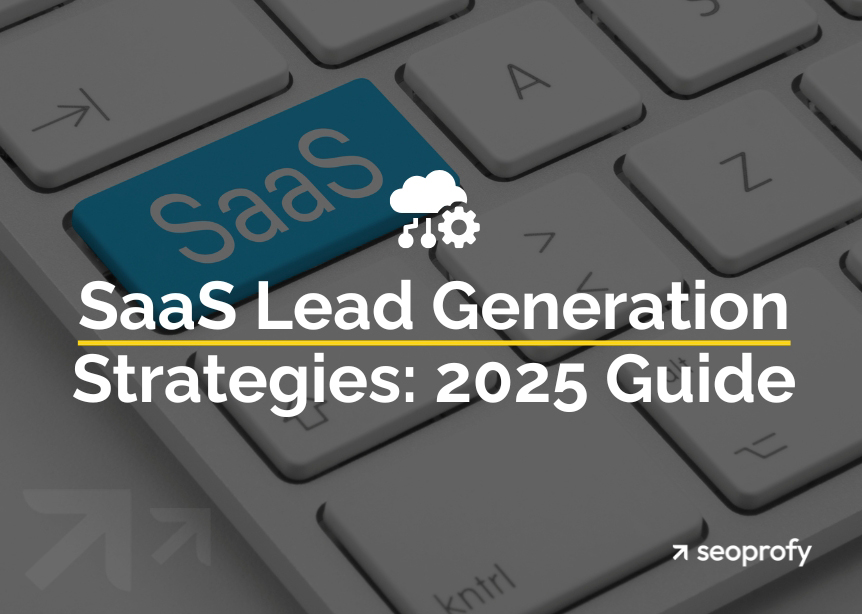SaaS buyers do a lot of research before they book a demo or click “start a free trial.” They compare features, look for relevant use cases, and size up your credibility. This makes SaaS content writing a core part of every product marketing strategy.
In this guide, you’ll learn tips on how to create SaaS content that draws in potential customers at different stages of the buyer’s journey. We’ll also share publication types that work best for attracting leads. By the end of the article, you’ll get plenty of ideas on how to improve your SaaS content and get better ROI from your efforts. Let’s get into it.
- Knowing who you’re marketing to (e.g., your buyer personas) and their pain points is the first step in a content strategy, as it shapes the kind of texts you need to create.
- Strategic SaaS texts educate prospects early with guides and move them closer to a decision with comparison pages and case studies.
- Internal links help readers find relevant content and stay longer on your site, and they also pass SEO value.
- Blog posts remain a top choice for software-as-a-service businesses. In fact, 33% of marketing teams use them to drive leads and organic traffic.
What Is SaaS Content Writing?
SaaS content writing is the process of creating written communication that helps people understand, trust, and eventually buy into your product. This type of writing can take many forms, including:
- Blog articles that answer specific pain points
- Product pages that show features and benefits
- Landing pages that encourage signups or demos
- Emails that teach and re-engage users
- Use cases that demonstrate your product in action
All of these content types work together to support the user’s journey from initial interest to conversion. We’ll talk more about this in the later sections, but overall, SaaS content is what helps businesses build brand awareness, draw in search traffic, and create that “aha” moment when your target audience knows your product is the perfect fit for their needs.
What Is Special About Writing SaaS Content?
In contrast to general copy creation that aims to reach a broad audience, content writing for SaaS is more targeted, as its goal is to nurture prospects and turn them into Marketing Qualified Leads (MQLs). Let’s look at other differences below:
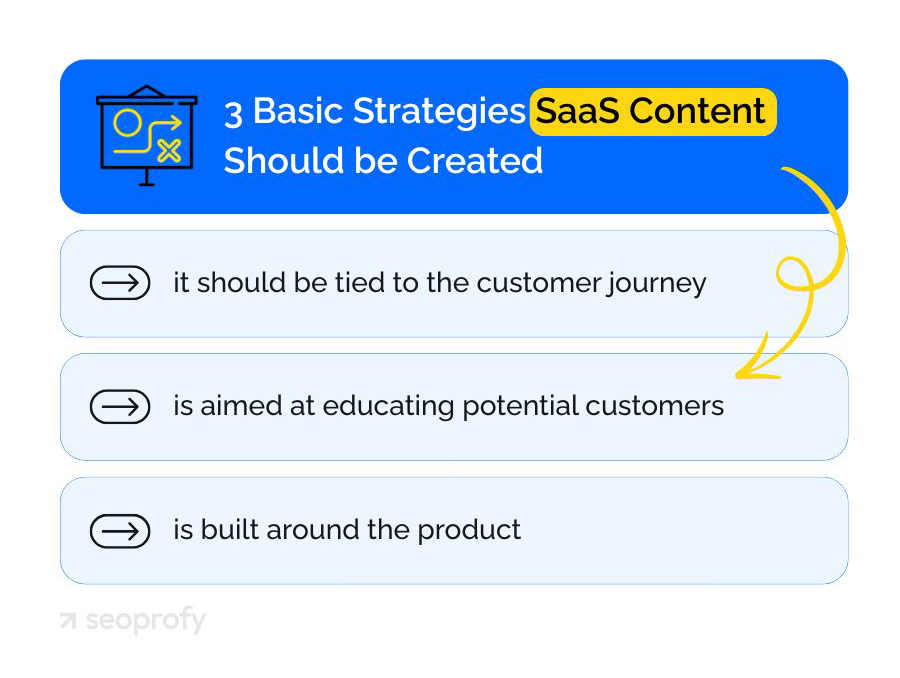
- The strategy is tied to the customer journey: Each piece of SaaS content is written to guide potential customers through the funnel — from the awareness stage, where people are still figuring out what kind of tool they need, to consideration, where they’re choosing between options, and finally to purchase.
- The content is mostly educational: Guides, tutorials, walkthroughs, and knowledge hubs are common types of long-form content you can find on SaaS sites. These aim to educate potential customers on use cases, integrations, and technical aspects of their product.
- SEO is built around the product: SaaS content is product-led. This means it targets search terms that relate to features, workflows, or problems the piece of software solves. For this reason, it’s more technical than general content writing and requires SaaS writers to not only understand the product specs but also tie them to the customer pain points.
Why Invest in SaaS Content?
The number one priority for any company is to attract, convert, and retain potential customers. And a well-planned SaaS content writing strategy directly supports that process. Below, we’ll show you exactly how.

Builds Authority and Trust
Your potential customers are more likely to trust you when you publish tutorials, client stories, case studies, and help articles, as it shows that you understand the exact problem they are trying to address.
We’ve seen this ourselves. After we published our SaaS SEO case study, we noticed people were a lot more willing to reach out and ask about our process.
That credibility goes hand-in-hand with your SEO performance, too. That’s because high-quality content contributes to your domain authority, which can eventually help improve your rankings in SERPs.
Enhances Your Visibility in Multiple Channels
People don’t only find SaaS products through search. They also see them mentioned in industry newsletters, shared in Slack groups, featured in software lists, or suggested by AI tools.
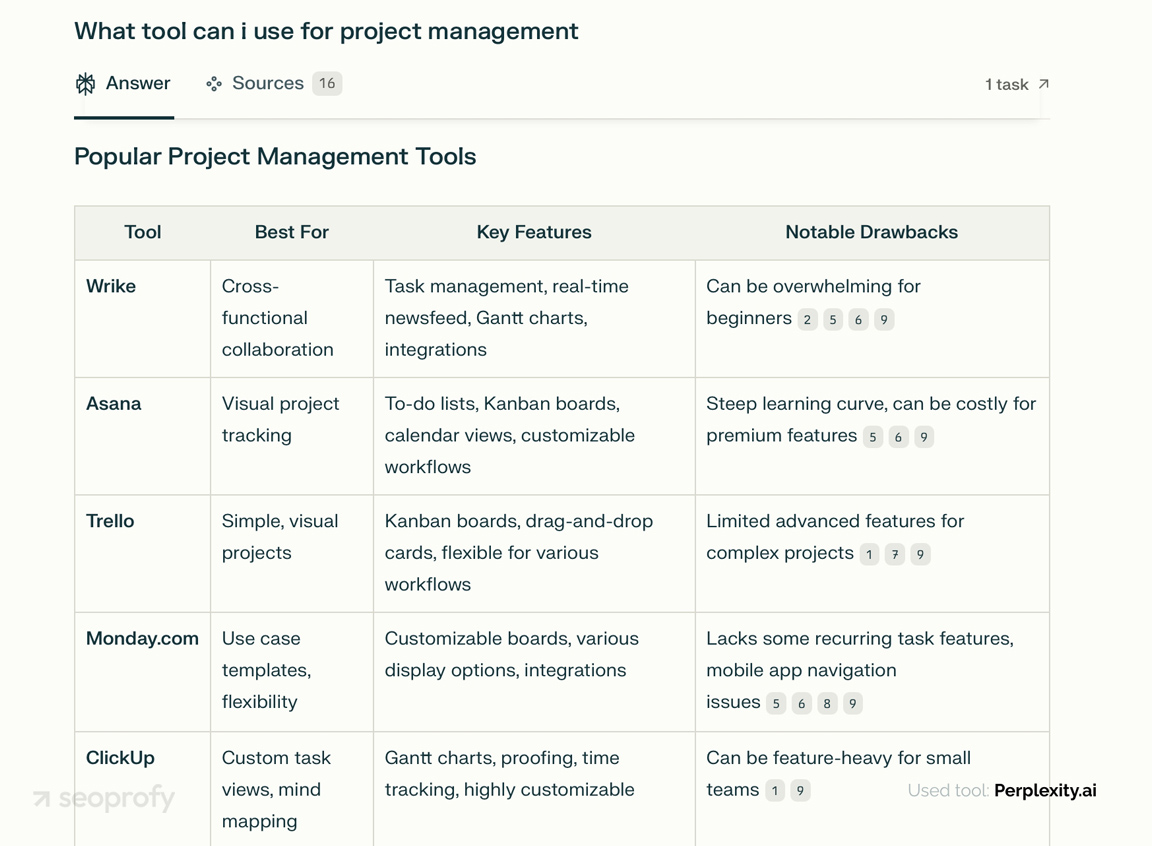
So, when you publish a high-quality piece of content, there’s potential that it’ll get shared in other places or even get picked up by Large Language Models (LLMs). Since SaaS buyers are often tech-savvy and use ChatGPT or Perplexity to research tools, it might increase your chances of getting more leads.
Improves Engagement and Retention
One of the advantages of SaaS content writing is that it helps you with both user acquisition and retention. A new feature walkthrough or a how-to guide can help people learn something they didn’t know your product could do and give them new ways to apply your tool in their day-to-day life or work.
What’s more, you could publish content in a variety of formats, such as video, infographics, webinars, polls, or even appear in a podcast your target audience already listens to (we’ll share the exact tool you can use for it later on). This will encourage your target audience to engage with your brand and come back for more.
Increases Conversion Rate and Revenue
In the 2025 State of Marketing Report, Hubspot mentioned website content and blog as one of the channels with the highest ROI. So, in addition to other benefits, SaaS content marketing brings you more sales, all through written assets that work long after they’re published.
This is because several content types, which we’ll share in the next sections, nudge your visitors closer to a signup or a purchase. Over time, that’s what helps turn traffic into revenue.
We work with SaaS content writers who can explain complex features, speak to technical buyers, and support product-led growth. Receive a copy that:
- Brings in qualified leads through targeted content creation
- Turns product features into practical value
- Supports conversions across every stage of the funnel

10 SaaS Content Writing Tips
Now that you learned the importance of content for SaaS companies, we’ve prepared ten tips that’ll help you see better results from your marketing efforts.
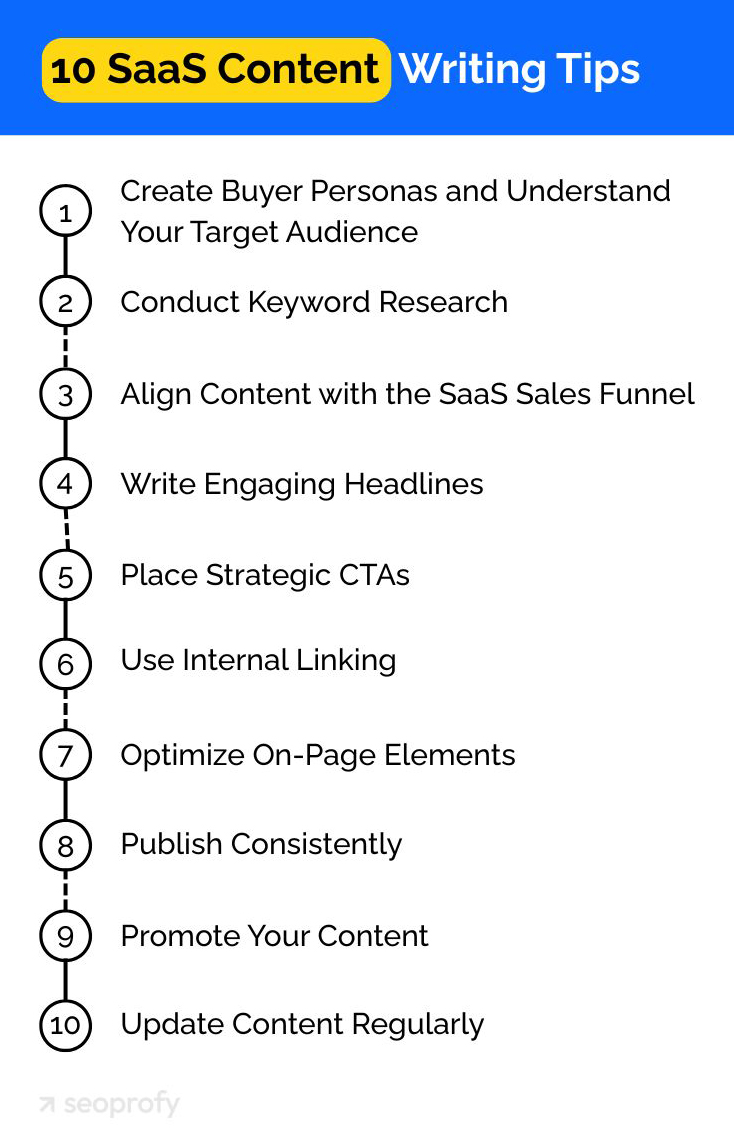
1. Create Buyer Personas and Understand Your Target Audience
In SaaS content writing, everything starts with your Ideal Customer Profile (ICP) and buyer personas. You need to know who you’re speaking to, how your product fits into their daily life, and what kind of answers they’re hoping to find when they land on your blog or product page.
You also want to pay attention to the language they use, how they describe their problems, and what kind of content they engage with. This will help you write copy that feels relevant and ties your SaaS product directly to people’s needs.
There are several ways to create buyer personas or learn more about your ICP. You could talk to your existing customers and review common support questions or sales call transcripts. To take it one step further, you can also use these tools:
- SparkToro – to learn where your audience spends time (more on that later)
- Hotjar – to understand user behavior on your site
- Typeform or Google Forms – to run customer surveys
- Miro or UXPressia – to map out personas visually
Once you know your target audience better, the next step is to find the exact words and phrases they use when looking for software solutions like yours.
2. Conduct Keyword Research
SaaS keyword research helps you map out your content with what people search online and gives your articles higher chances at ranking in search engine results. There are several ways to do it.
The fastest one is to use an SEO tool like Ahrefs. You can type in a topic related to your product in the keyword explorer and check what keywords come up. You can also filter them by difficulty, search volume, or traffic potential.
Another trick you can try in SEO content writing for SaaS is to type your solution into Google and see what shows up in the auto-suggestions. This method works well for finding long-tail keywords, which commonly have a buyer’s intent.
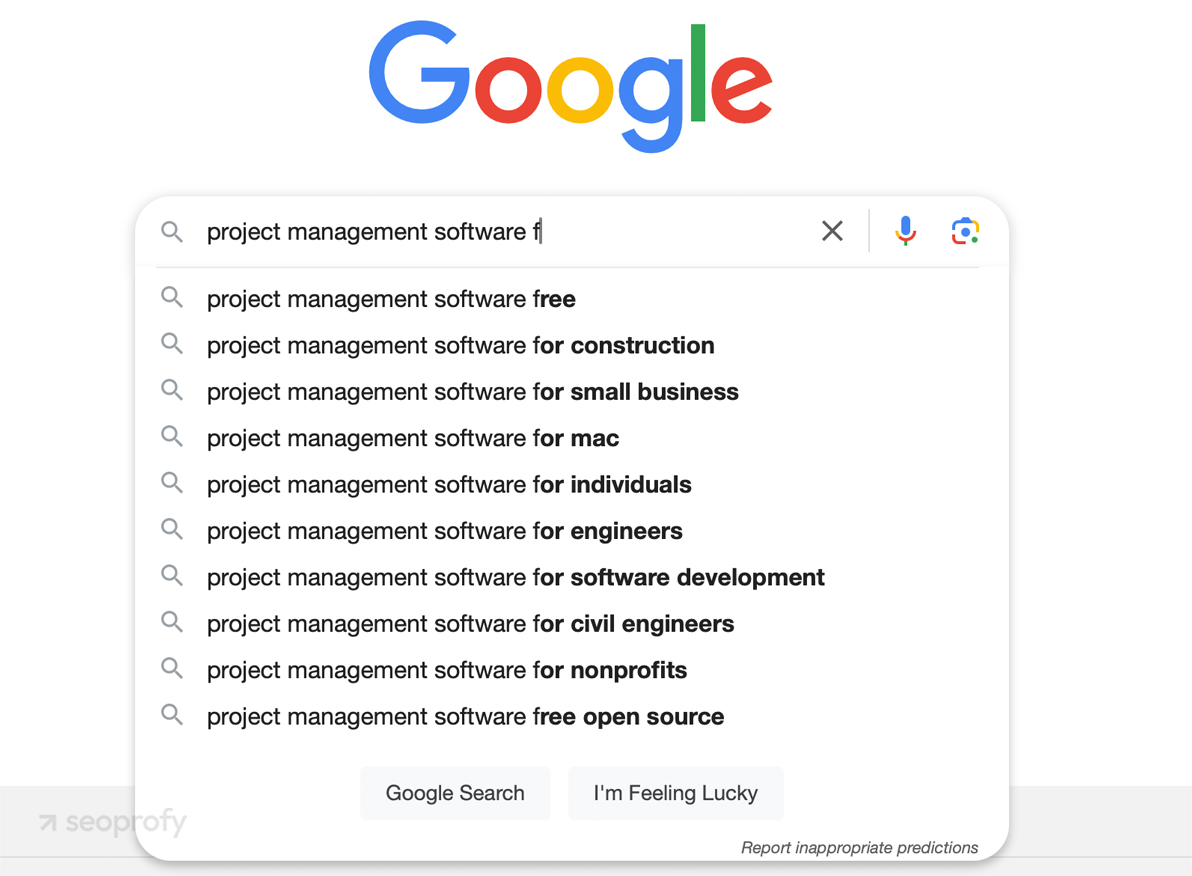
Finally, check your competitors. In Ahrefs, you can plug in their domain and look at the top-performing pages and search terms they rank for. If they’re ranking for something relevant to your product, that’s a shortcut to choosing keywords for your own list.
3. Align Content with the SaaS Sales Funnel
Even though the buyer’s journey in the B2B software-as-a-service industry isn’t always linear, content writing in SaaS should still address each step — from initial curiosity to research and, eventually, purchase. To create a content strategy that meets them where they are, you’ll have to understand their needs at each stage.
- Awareness stage: People at this stage only start to realize they have a problem and don’t yet have a solution in mind. They’re mostly searching for informational content. Think how-to guides, explainers, and top-of-funnel blog posts.
- Consideration stage: At this point, people know what category of tool they need and are starting to do the research. This is where you can write valuable content that matches their search intent. For example, feature explanations, integration walk-throughs, use case pages, or comparisons.
- Decision stage: That’s when people have seen enough and are now trying to choose one of the solutions. Formats like case studies, ROI breakdowns, and pricing pages usually work best for this stage.
4. Write Engaging Headlines
Headlines are your brand’s opening line. It’s the first thing people notice, and it either draws them in or pushes them away. Overall, there’s no magic formula, but a few simple tips can help you write better headlines:
- Use emotional triggers to make people feel something
- Keep it simple and easy to understand
- Include your target keyword for better search visibility
- When relevant, add action verbs, numbers, or stats
As for the formats, benefit-driven headlines, how-to titles, and questions that tap into a specific problem tend to perform the best in SaaS content writing.
5. Place Strategic CTAs
SaaS is a conversion-focused industry, so you need to add CTAs throughout your content to nudge your readers toward trying a demo, starting a free trial, or even becoming a client. Here are some best practices you can follow that we often use in our SEO copywriting services:
- Use actionable language
- List the benefits of your product
- Sprinkle in some social proof
6. Use Internal Linking
Internal links help Google understand your site’s architecture and the connection between pages. But more importantly, they pass link juice to your other pages, improve user navigation, and let you decide where to send users next. Here are some best practices to keep in mind in:
- Link from high-authority blog posts to less-authoritative ones
- Connect your homepage to core pages (e.g., features, solutions, and integrations)
- Place internal links inside the main content, not in sidebars or banners
- Use descriptive and varied anchor text
- Link to demo and integrations pages in the header and footer
Say you take seriously your SaaS blog writing and have a high-performing post that has 120 backlinks. Instead of letting all that authority sit there, you can link directly to your conversion pages or demos. That way, you pass SEO value to pages that don’t usually earn backlinks on their own (e.g., bottom-of-the-funnel pages).
7. Optimize On-Page Elements
After keyword research, you’ll need to outline the technical elements of the page. This helps keep your SaaS content writing consistent with your target phrase and supports how your page performs in search engines. Here’s where you’ll need to pay attention:
- Title tag: Add your main keyword for relevancy and keep it under 60 characters so that it displays fully in search.
- Meta description: Write a one-line summary, around 155 characters, that explains the content on the page and gives people a reason to click.
- URL slug: Keep it short, descriptive, and don’t include any numbers.
- Headings: Use only one H1 per page and add H2s and H3s to break the content into sections.
- Image alt text: If you plan to add visuals, write alt text that describes the context of the image.
8. Publish Consistently
The research by StrataBeat found that B2B SaaS companies that published over 9 blog posts per month saw their Google website traffic grow by 35.8% year-over-year. In comparison, their counterparts that posted only once to four times a month saw just a 16.5% increase.
Sites that publish regularly also tend to get crawled more often, which means their B2B SaaS content gets indexed faster. And the more quality pages you have, the more search terms you can show up for.
Still, when it comes to creating content for SaaS, the right publishing frequency depends on your resources. It’s better not to spread your efforts thin and only post as often as you can create exceptional copy. At the end of the day, one expertly written post each week can do more for you than five mediocre or AI-generated pieces.
9. Promote Your Content
If you want more people to see your SaaS content writing efforts, you’ll need to have a promotion strategy in place. The first thing you can do is decide on the channels. Research from Orbit Media shows that most bloggers use social media (90%), search engine optimization (65%), and email marketing (65%) to get their content in front of people.
That’s a good baseline. But if you want to be more strategic, you’ll need to figure out where your potential customers already spend their time. In other words, you need to know their “information diet.” What do they read? Where do they hang out online? Are there particular channels that they prefer?
Tools like SparkToro can help you find those answers. Once you know where attention already exists, you can start working on link building for SaaS and show up in those places with your content.
10. Update Content Regularly
Finally, it’s a good idea to update your pages over time. Google prioritizes refreshed content that offers users the most up-to-date and relevant information. So, you’ll need to revisit your pieces every 3-4 months to add new information, check internal linking, and update screenshots if needed to help your content hold its place in search results.
Types of SaaS Content for Getting MQLs
With tips covered, we can now move on to content that drives more leads. Below, we’ll share the types that growth marketers and SEO specialists swear by.
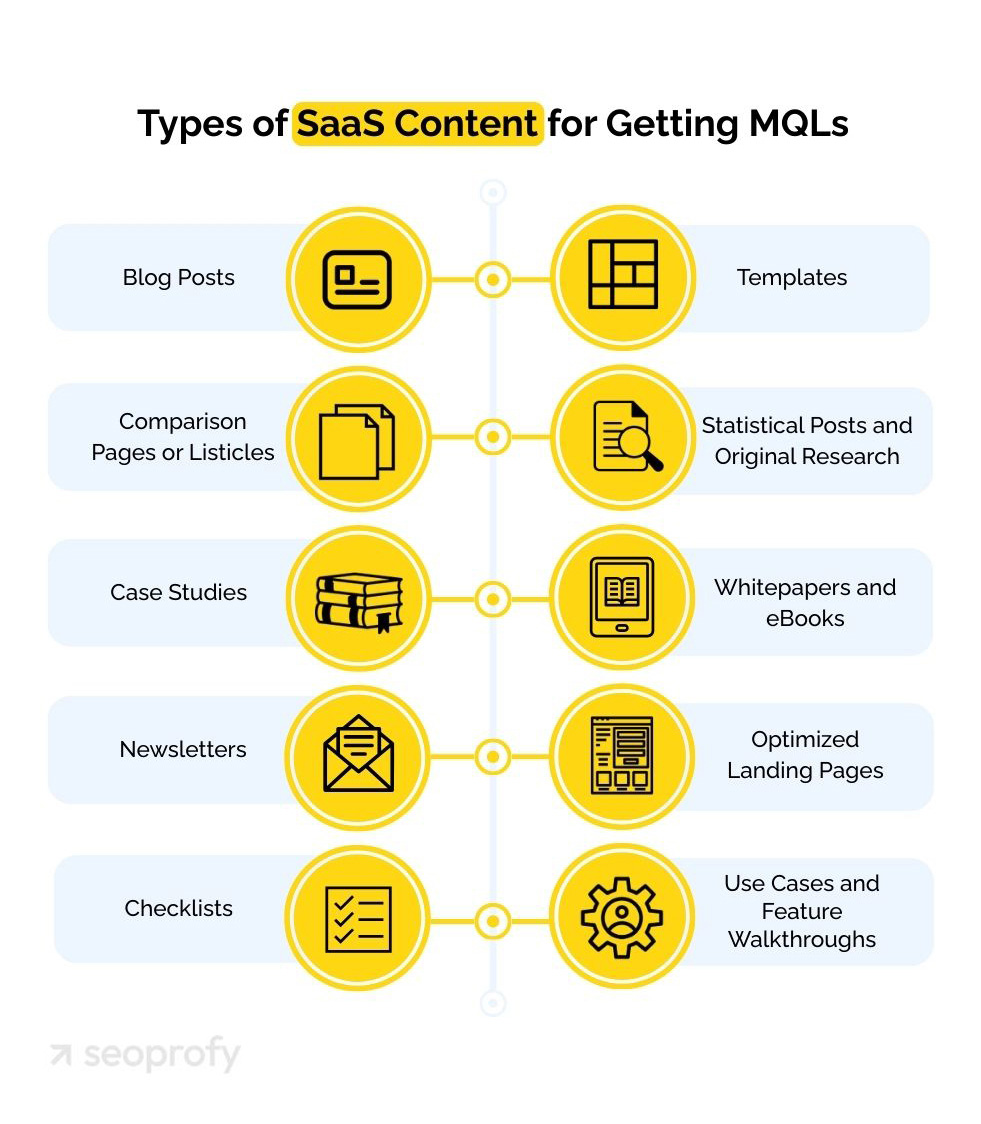
Blog Posts
SaaS blog content writing is probably the most well-known content format. As HubSpot’s data shows, 33% of marketers include blogs and articles in their overall marketing strategy.
The trick is to write engaging SaaS content that speaks to your prospects’ pain points. These are how-to guides and educational resources, where you walk readers through a task they’re trying to figure out.
When targeting MQLs, content writing for SaaS companies is less about casting a wide net and more about helping someone who’s already halfway there. They’re already thinking about solving the problem, so they’re more likely to convert.
You can also use “best tools” lists or comparison posts to help readers connect the dots between their problem and your solution. We’ll have dedicated sections for these posts below.
Comparison Pages or Listicles
Another way to attract qualified traffic with your SaaS content writing efforts is through comparison blog posts. You’ve probably come across these before and maybe even picked a tool because of one. So why are they so effective at generating leads?
People are busy, and when they’re looking for a tool, they don’t want to jump from website to website but would rather find everything in one place. That’s why SaaS websites like ClickUp create pages where they compare their solution to alternatives on the market.
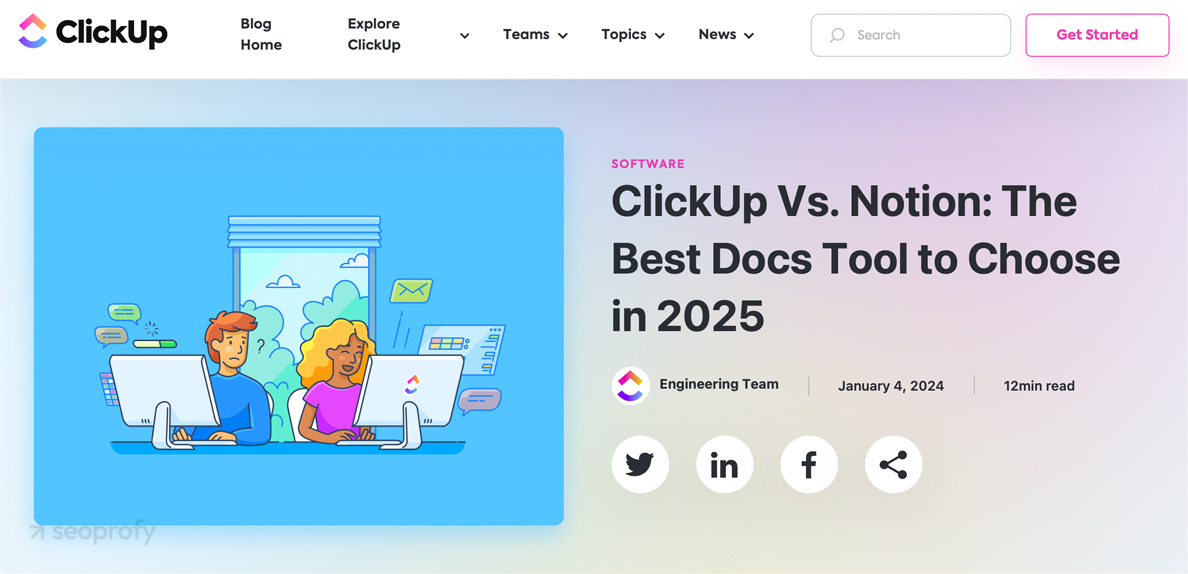
The goal of writing comparison blog posts is to win over people who are currently in their research or decision phase. You can show exactly how you stand out from competitors and lay out the difference in features, specifications, pricing, and use cases.
Case Studies
The fastest way to build trust with your audience is to show them how others have already saved time, money, or improved a certain aspect of their lives with your product. Asana does this well through their customer stories.
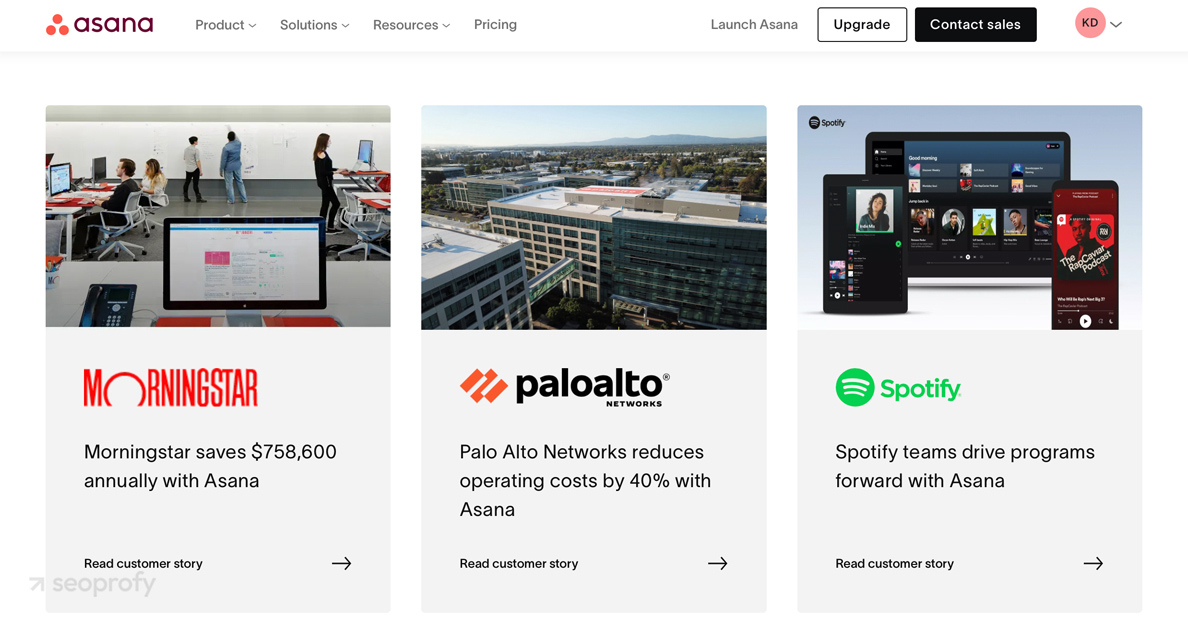
In each story, Asana shows the problem the client had and how their product solved it. You could follow a similar approach in your SaaS content writing and, at the end of each case study, encourage your readers to start their own success story by signing up for a free trial or demo.
Newsletters
Although newsletters don’t live on your website, they are still an effective way to reengage people who’ve already shown interest in your product.
Product tips, customer stories, and bite-sized use cases all work well for newsletter content. The best approach is to focus on things that can help your prospects get more out of your product or understand how others are using it.
Miro, for example, sends regular emails with templates based on different team workflows. This kind of strong content keeps people engaged and often moves them toward the next step (e.g., logging back in, learning about a feature, or starting a paid plan).
Checklists
The other SaaS lead generation content type is checklists. You can use them for onboarding flows and feature adoption. In contrast to blog articles that explain the process in paragraphs, you lay it out step by step.
Brands like Zapier use checklists when explaining their integrations, known as Zaps. When new users want to connect their apps for automation, they’re guided through each step in a specific order.
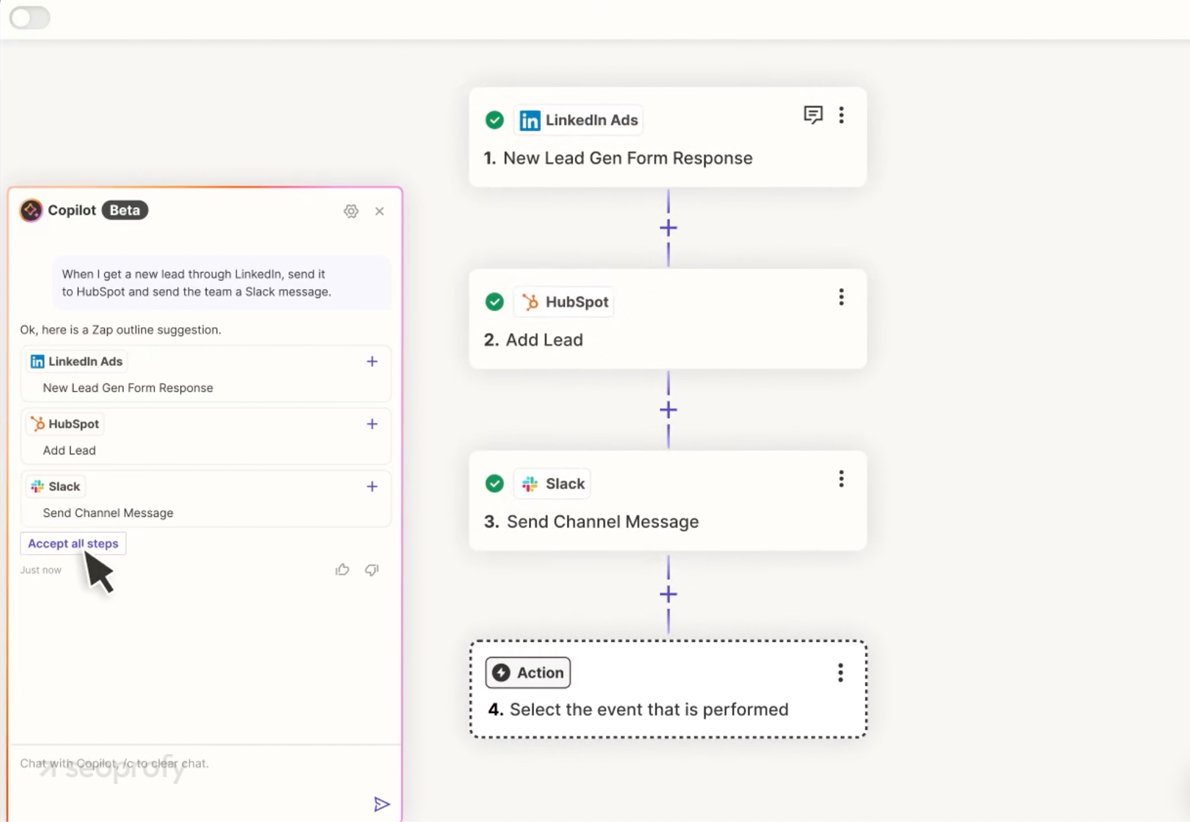
You can follow a similar approach and try this content type for your onboarding or feature walkthrough.
Templates
Just like checklists, templates offer users a faster way to complete a task. But instead of guiding them step by step, you give them a starting point that’s already half-built.
You’ll see this a lot in SaaS content writing strategies. Notion, Zapier, HubSpot, and others all offer templates to help users get started faster. For example, Notion has plenty of pre-built project management lists that teams and individuals can customize. Users simply pick a template and add their own information, which saves them a lot of time.
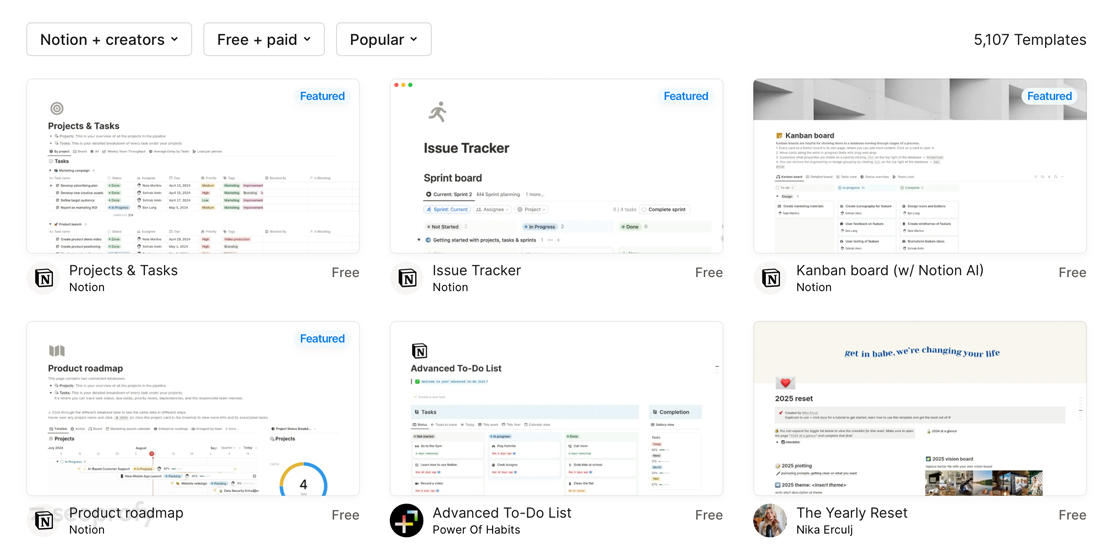
It’s also a smart move from an SEO perspective because templates attract plenty of organic traffic to your site. You can try to speak to your customers about what templates would be helpful for them as part of your solutions, and then integrate them into your strategy.
Statistical Posts and Original Research
B2B SaaS websites that offer original research see, on average, a 29.7% lift in organic traffic. For those that don’t publish this kind of content, the increase is just 9.3%.
For this reason, SaaS companies regularly use this copy type in their strategies. You don’t need a big research team to do it, either. A simple survey, insights from your product, or customer data can all work. The point is to share something people can’t just find with a quick Google search.
Whitepapers and eBooks
More than half of marketers say whitepapers and eBooks are among their most effective SaaS content writing types. These are often used to explain a complex process, walk through new industry trends, or show exactly how your product can help with a specific pain point. HubSpot often publishes ebooks about inbound marketing for SaaS.
These pieces are usually at least ten pages long, with examples, screenshots, or even some of your own data. This is a straightforward way to give value and collect qualified leads. You can also pull out sections from your ebooks and use them as blog posts or social exceptional SaaS content later on.
Optimized Landing Pages
In the software-as-a-service industry, your landing pages can pull double duty. Not only do they collect signups and demo requests, they also rank in search for core features or services. Say your company offers workflow automation for remote teams. You could have a landing page dedicated to that exact solution and optimized for relevant keywords.
People searching for that term find you, see what you offer, and can get started right from that page. You could also add a strong headline, list a few benefits, and maybe add a customer quote or two.
Use Cases and Feature Walkthroughs
Out of all the SaaS content writing types, use cases and feature walkthroughs work especially well for generating leads. They give your target audience a better understanding of your product and show how a specific feature can help them tackle their problems. Take Clay, for instance. On their website, they offer visitors feature overviews with embedded use cases.
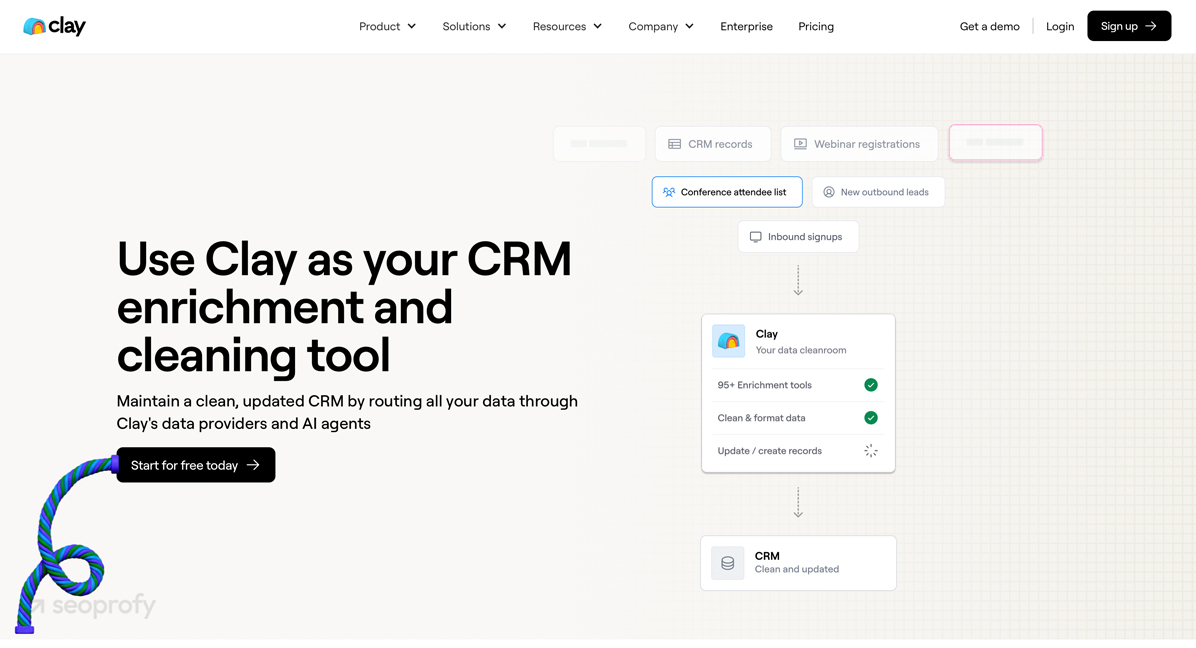
Each page describes the issue and points out the exact features that fix it. They use annotated screenshots, workflow diagrams, and sometimes quick video demos to help people see how everything comes together.
This format hits the mark in SaaS because it moves the conversation from “What does this tool do?” to “How can this tool help me?” It also builds trust with the buyers, as they are more likely to try a product once they see how it applies to their own use case.
Best Tools for Creating SaaS Content
In your SaaS content writing strategy, you’ll also need certain software to make the creation process more efficient. So, here are some of the marketing and SEO tools you can use, and what they’re best at:
- Ahrefs: Check what keywords your competitors rank for and where their traffic comes from. See the matching terms report to see relevant keywords in your niche and filter them by search traffic, competition, and intent.
- SurferSEO: Optimize SaaS content by comparing it to top-ranking articles for your target keywords. Surfer gives you word count, keyword suggestions, and related topics to include, which is handy for boosting visibility in search.
- Notion: Use it to build your editorial calendar, manage outlines and drafts, assign tasks, and track everything in one place. You can create templates for briefs or tag articles by funnel stage or persona.
- ChatGPT: Create outline articles based on your keywords and competitors, draft short-form content like onboarding tips or support answers, and analyze performance. Another advanced way to use it is to add your customer data from audience research tools like SparkToro and ask it to create a content marketing strategy based on that data.
- SparkToro: Find out where your audience spends time online, what podcasts they listen to, and what social media channels they use. They recently added a new section that also shows what topics they might be interested in, which can give you ideas on what to write.
- Customer.io: Use it to send automated product updates, onboarding emails, or drip campaigns. You can segment your audience by behavior and send them content that matches their needs.
How to Measure SaaS Content Effectiveness?
Publishing is only step one. To know whether your SaaS content writing is working, you’ll also need to check a few metrics, and most of what you need lives in Google Analytics 4 (GA4) and Google Search Console (GSC). Here’s what to look at:
Organic Traffic
Google Analytics 4 (GA4) shows how many people land on your articles and landing pages. Here, you can look for trends over time. If you go to Reports > Engagement > Pages and screens, you will see which topics draw the most attention.
Leads
In GA4, set up events for your main actions (like form submissions or button clicks) to connect leads back to specific pages. This will help you track signups, demo requests, or other conversions that come from your content marketing efforts.
Conversion Rates
Visitors are important, but you’ll also need to know what they do after they come to your site. Use GA4 to measure the percentage of people who read your content and then take the next step, whether that’s signing up or requesting more info.
Engagement
To understand how people perceive your SaaS content writing, you can look at how long people stay, how far they scroll, and if they interact with your calls to action. Metrics like “Average Engagement Time” and “Event count” in GA4 help you pinpoint which pages keep readers interested.
Rankings
For this metric, you can use Google Search Console or an SEO tool. Check which keywords your pages show up for, how many clicks they get, and where you rank in search results.
That said, it’s good to remember that you might not achieve your SEO goals right from the beginning. Although it’s possible to see some quick wins early on, the biggest results often show up months after you hit publish.
Upgrade Your SaaS Content Strategy
SaaS content writing is undoubtedly one of the most effective channels for product businesses that want to draw in more organic traffic, build topical authority, and get more customers. The important thing is to keep at it and post consistently.
Still, you don’t have to try every tip and content type we shared today. Start with a few ideas, see how your audience responds, and then double down on what brings in signups and conversations.
And if you want to skip the learning curve and improve your current strategy right away, reach out to our SaaS SEO agency. We’ve helped multiple SaaS businesses see better ROI from their content writing efforts, and we’ll be happy to build a custom strategy for you, too.










